Ford Is Doing Something Interesting With the 2024 Mustang GT's Underbody Aero
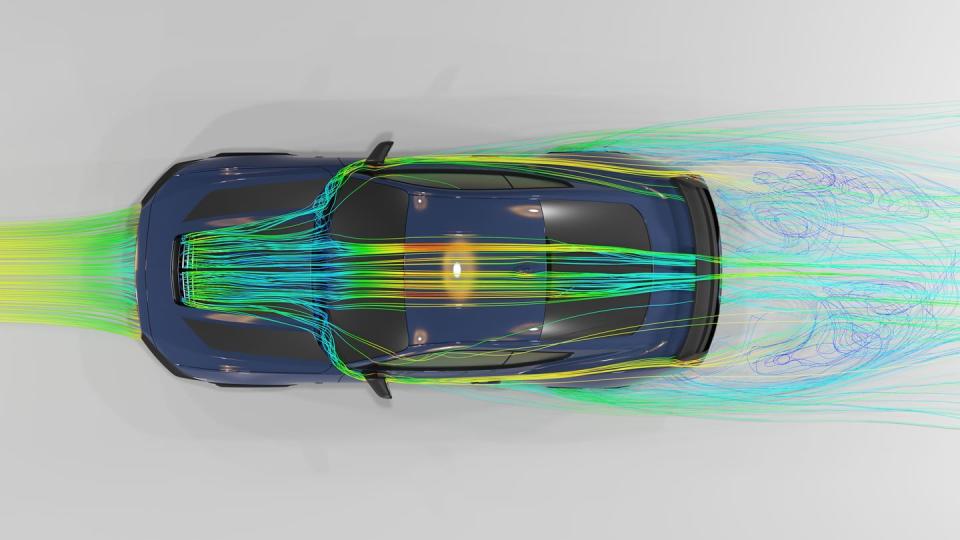
One of the first things I noticed on the 2024 Ford Mustang GT were a pair of strakes sticking out underneath the car when looking directly at the splitter. Further inspection revealed that I was looking at a new aero device for the Mustang, which led me to poke around further. I quickly discovered that Ford had done quite a bit of work under the car.
Working as a professional racing mechanic in both sports car racing and NASCAR has allowed me to examine a variety of aerodynamic configurations, and most of the modern race cars that I’ve worked on or analyzed have some sort of flat underbody with various devices to direct airflow. Together they're an attempt to maximize downforce or minimize drag as necessary. Even off the track, I can't help but inspect street cars more closely. In the case of the Mustang GT that I recently borrowed, it led to me crawling around the car in a parking lot because it was so interesting underneath.
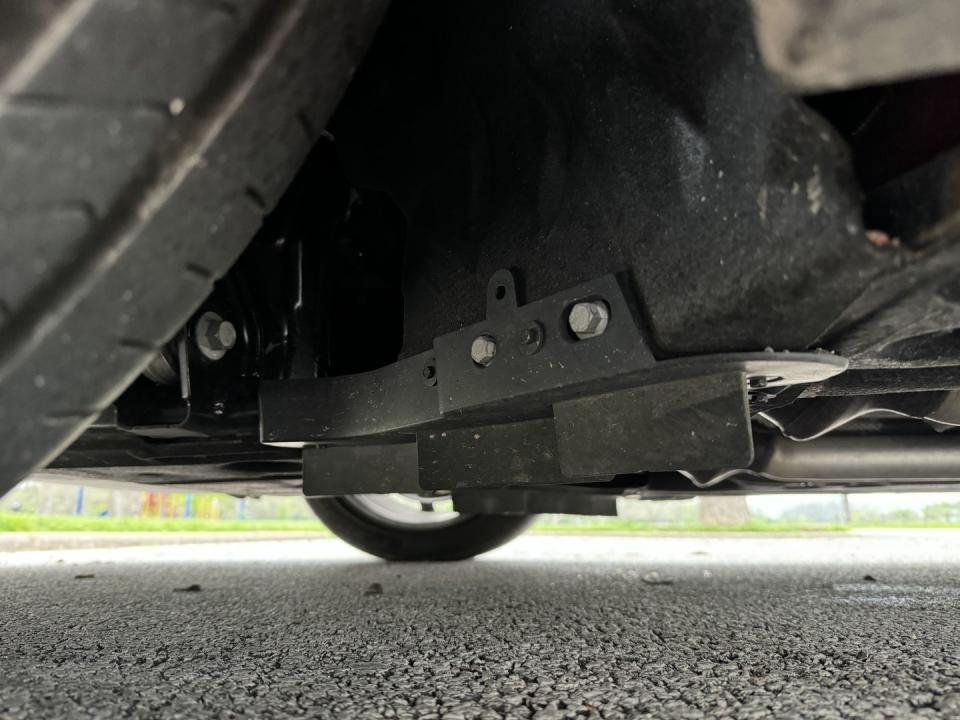
This was a Mustang GT with the Performance Package, which borrows some of the Dark Horse aero components along with the handling upgrades that are part of the package. The strakes in question are one of those components which were borrowed from the Dark Horse. They are mounted under the car directly behind the splitter and beside the wheel well openings. It is apparent that they receive airflow from the splitter and then route it to the belly pan behind them, but in order to better understand why they were there I reached out to Ford and chatted with Mustang aerodynamicist Jonathan Gesek.

Gesek shared that the strakes are purely present for downforce on the front end of the car. It's something that has been a long term project for him. He added that he had attempted to implement stakes on a Performance Pack and Mach 1 variants in past generations, but it wasn’t until the rest of the underbody was redesigned that they were actually able to successfully implement them. Gesek shares that the key piece to activating the strakes were components called rocker shields, which he described as “big black plastic shields underneath, basically between the tunnel and the sill and the front rear wheel." These are present on all 2024 Mustangs. They're flat panels that you would find if you went underneath the car directly below the doors.
During a video call, Gesek produced a CFD comparison of the standard Mustang GT underbody compared to the GT Performance Pack underbody, which showed a significantly larger low pressure zone behind the strakes on the Performance Pack. Creating a low pressure zone there helps to draw the car down to the ground, improving front downforce, in turn improving handling. The air that comes through the strakes gets dragged outboard as it makes its way to the back of the car, going across the belly pan and the flat covers adjacent to the rear wheels.
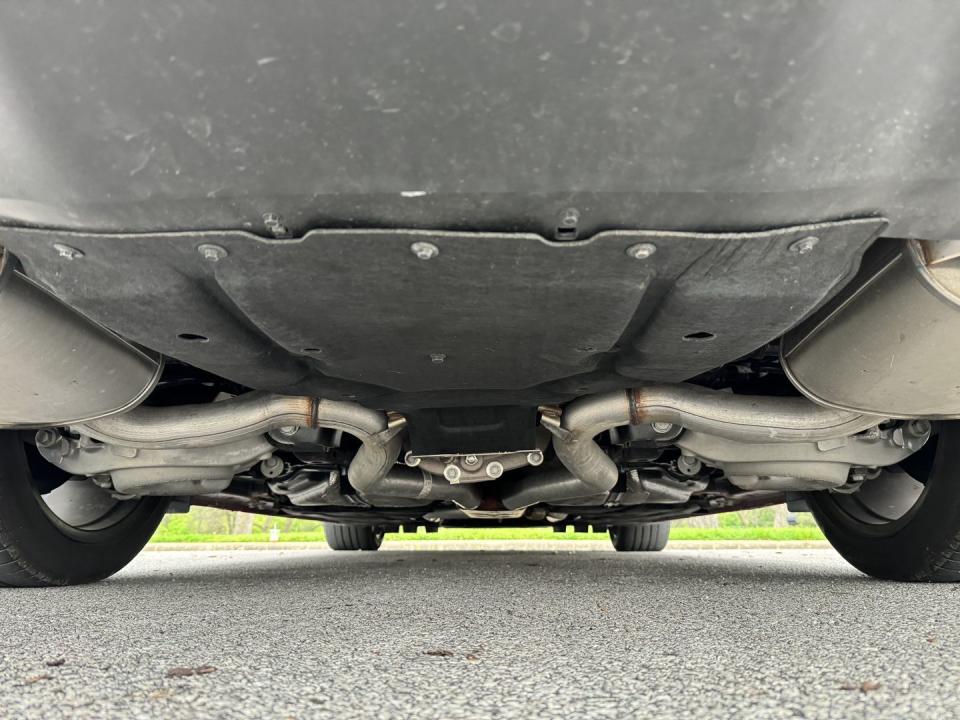
Not only do the strakes help clean up the airflow in front, but Gesek shared that they help move the air to the back. We see the same kind of air management on race cars. "As that air is getting dragged outboard," Gesek explainns, "it's also dragging all this air in the middle [between those plastic covers], spreading it out. That reduces the pressure on the whole underside of the car.” All this aero design is comparable to dedicated race cars that have a genuinely flat belly with small strakes.
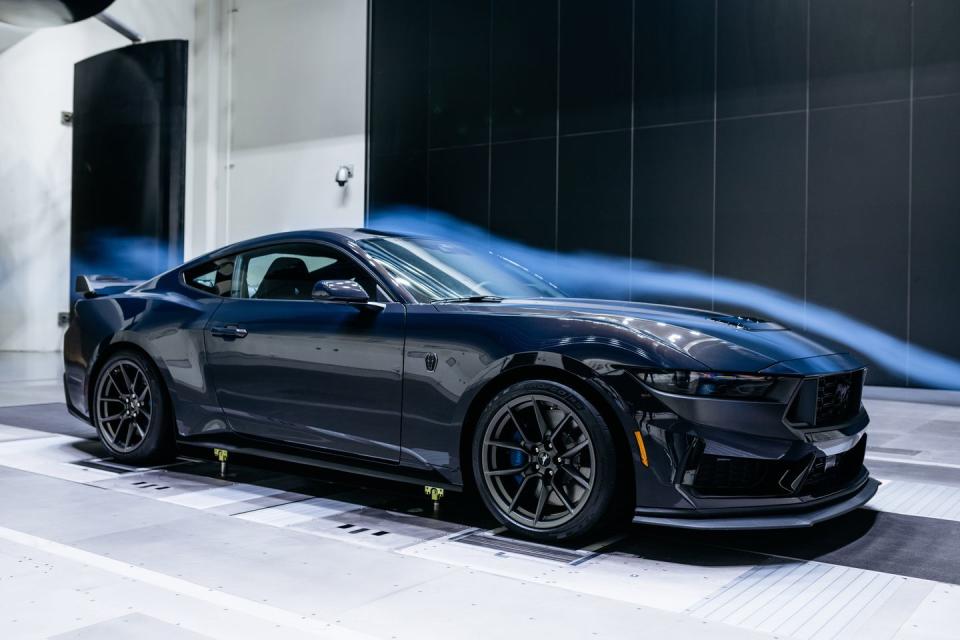
The racing influence can be clearly seen as soon as you crawl underneath the Mustang, because much of the underbody resembles a modern race car with flat panels covering every possible surface along with devices to move air like those strakes. I asked Gesek what allowed them to optimize that underbody and make things like the strakes work this time around. A big part of the equation, according to Gesek, was the new wind tunnel where Ford was able to develop the latest Mustang. The recently-launched Rolling Road Wind Tunnel at Ford not only allows the company to test at speeds up to 200 mph but Gesek shared that some of the biggest improvements are underneath.
“Honda likes to brag about their wind tunnel. Ours is faster," says Gesek. "So we drag a lot more air. I say drag on it, it sounds terrible. So we're able to recreate the underbody airflow much better in the new wind tunnel than in our previous tunnel.”
“Our old wind tunnel was very good. It continues to be. Our wind noise team still uses it," Gesek added. "It has very good airflow over the top of the car, but on a Mustang, because of how low they are, I'd say from the center of the wheel down its airflow wasn't fantastic. It's more like an aerospace wind tunnel than an automotive tunnel. So the new one is a really good tunnel. We have a really, really nice data system. The balance is super good. We can take really, really precise tight data and control the vehicle attitude of the car very tightly. It's a really cool place to work.”
Those strakes are part of what Gesek calls an “absolute package” when it comes to aerodynamics of the Mustang. They not only have to build the bodywork of their performance targets, but also have to counteract the detrimental aero impact of components added by other teams like coolers. This is quite apparent when you look at the front bumper of the car -- you see openings for things like the radiator, brake ducts, and oil cooler. Most of these openings create lift. The aero team always wants to minimize them, but when they’re not able to do so they create devices to route air to counteract them.
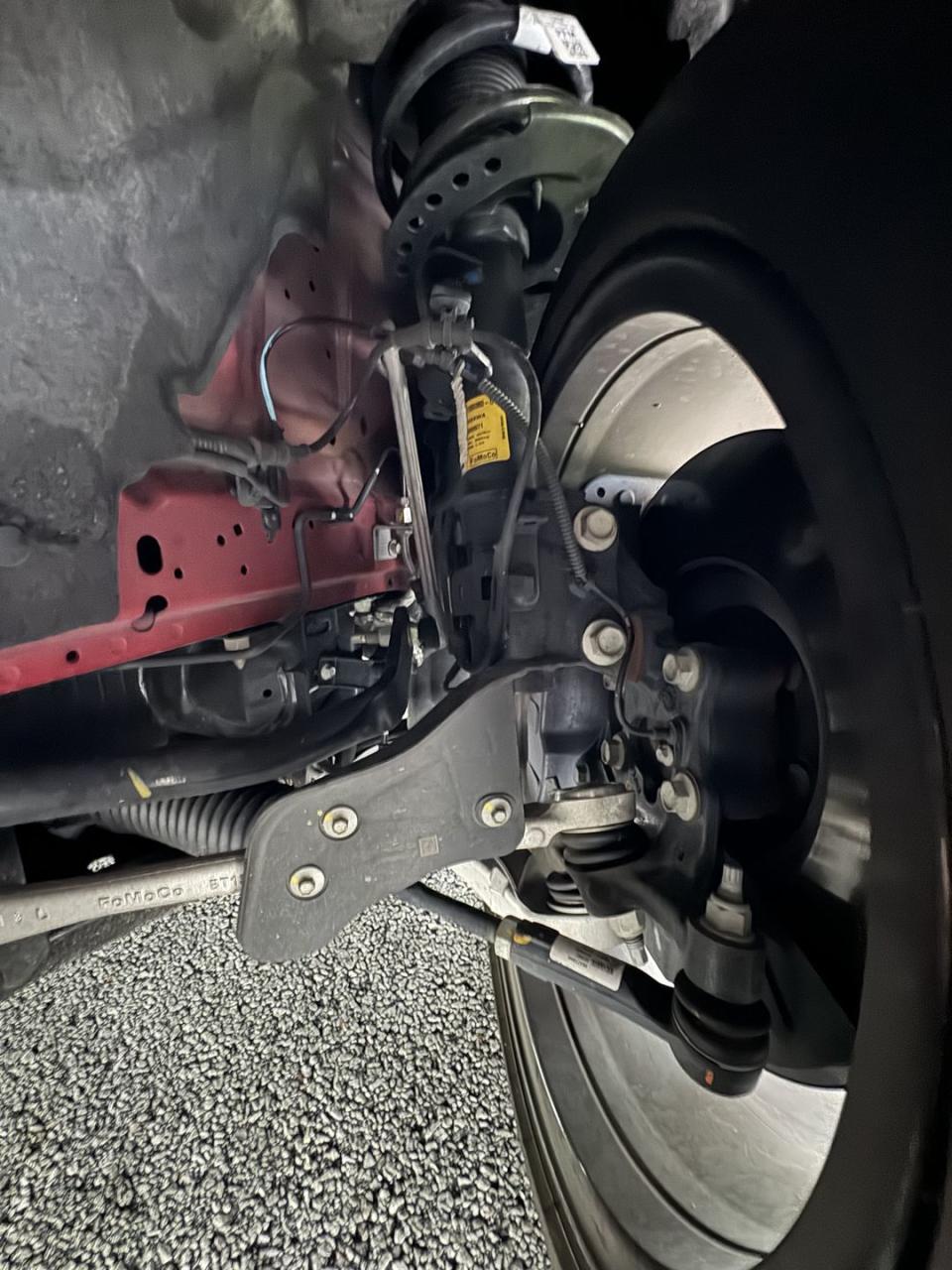
Performance brakes on the Mustang mean that a lot of cooling is required so there are brake duct tunnels built into the front bumper, but instead of leading to a hose they actually blow air at a small deflector attached to one of the lower suspension arms. This deflector is not only lightweight, but its design also allows for air to be received from multiple sources. In this case, Gesek and his team added openings called "brake ramps" directly below those brake duct tunnels. They can send air to those brake cooling deflectors without generating lift like brake duct tunnels that receive air right from the front bumper. The reason that the brake ramps don’t create lift is because they pull air in from below the splitter. This solution allows them to meet the requirements for brake cooling while keeping the brake ducts as small as possible.
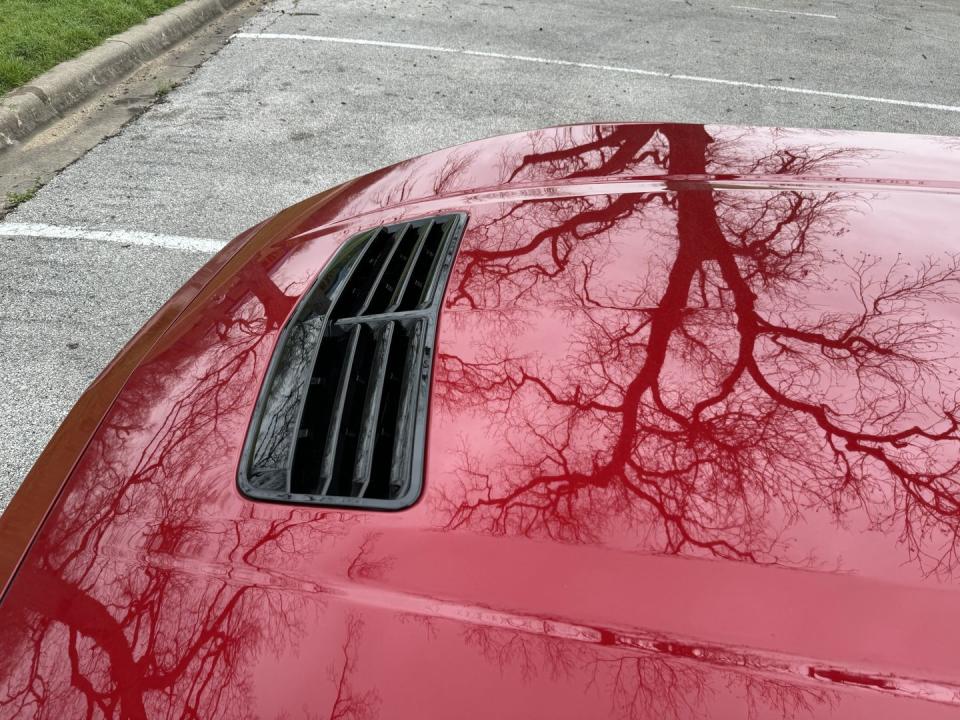
Another solution to mitigate lift at the front of the car is the addition of a hood vent to redirect airflow. “Any of the air that comes in the front of the car, it's got to go somewhere," Gesek explains. "If it comes in the front and it exits through the tunnel, which is where I think most of the air goes, you have a net momentum change in the vertical direction. And so if the air comes in high and exits low, then it's going to create lift. So if you can get the air to come in high and exit higher, that's going to be better for lift.”
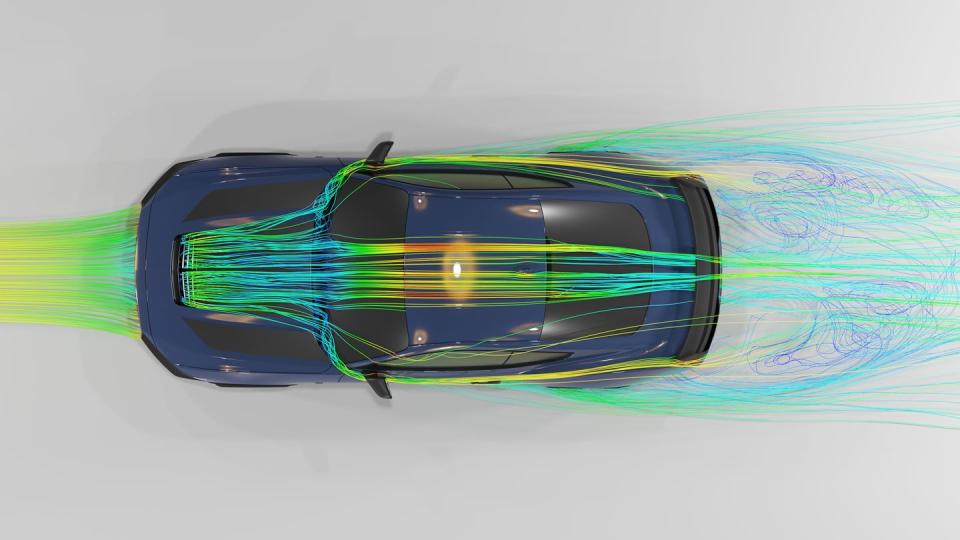
The hood vent is not only a functional lift-reduction device but is something that Ford has been able to maximize based on what it's learned from its GT3 and GT4 racing programs. The aerospace background from people like Gesek certainly doesn't hurt, either. He shares that the hood vent on the GT Performance Pack and the Dark Horse has an enlarged front slat called a "scupper" in order to accelerate the air coming out of the vent. Gesek added that the goal is “creating this low pressure zone behind that raised leading edge, which helps to draw more air out of that vent. So if we just had that vent flat on the hood, it'd be 20 percent as good as it is. Putting that little leading edge on it kind of turbocharged it.”
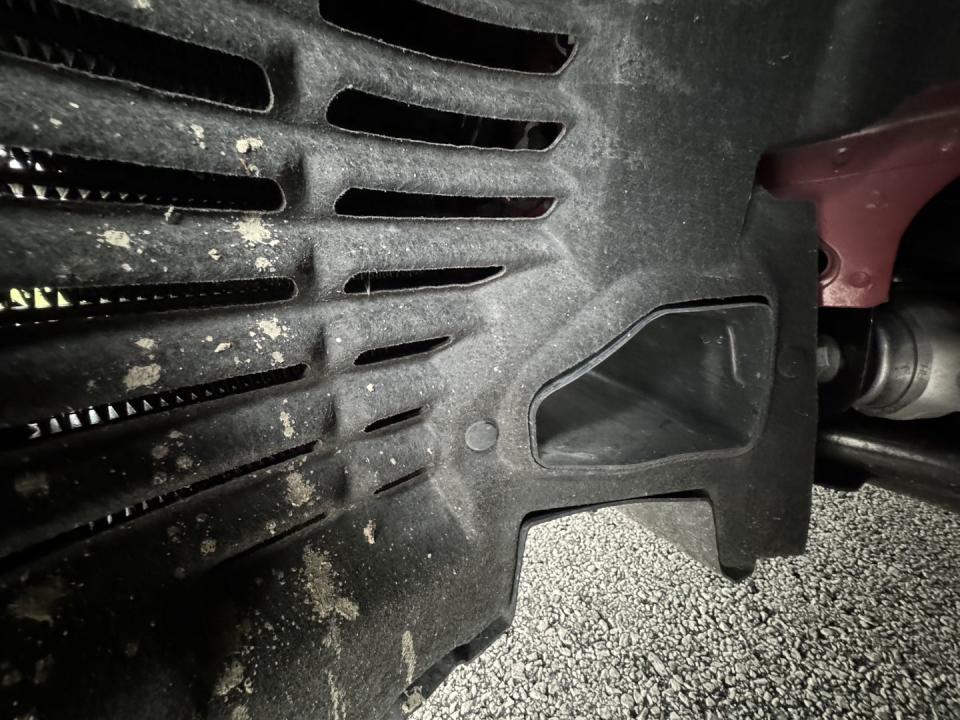
All of these components have to stand up to daily driving and live alongside a variety of other pieces. It's why Gesek emphasized how big of a win pieces like the vent or the strakes are, because they’re able to maximize real estate in other parts of the car. That tight fit is extremely apparent when you look at the fender liner on the front left of the car where the size and shape of that brake duct tunnel is dictated by the outlets for the engine oil cooler that are directly beside it. Not only do these components have to work alongside other pieces of the car but they also have to survive in the elements which can occasionally involve running over small objects on the road. Things that are mounted low like those strakes can’t be built from rigid carbon fiber like we see on race cars. They must be created from something a bit more compliant and flexible. In this case, Ford opted for what it calls a dual shot approach which features a plastic base with rubberized strakes over top of it. This allows Gesek's team to strike a balance of having strakes that are stiff enough to redirect airflow, but can also flex if impacted by something on the road.
One of the other benefits of using common materials to manufacture the strakes is the fact that their replacement cost is only around $150 for the set.Owners of lower trim Mustangs have started to seek them out in an attempt to add a bit more front downforce. The good news for these enthusiasts is that even the standard GT trim features the belly pans needed to activate the strakes, so they should see some benefit if they were to add them. Still, they won’t get the full effect of the GT Performance Pack or Dark Horse because of how the other components are positioned. Getting closer to the ground means that the underbody can be more efficient so lower-riding trims usually immediately have an advantage due to their ride height. Gesek shared, however, that Ford will also go as far as having some of the underbody panels installed lower on performance variants to maximize performance.
Designing a car like the Mustang to go fast is incredibly challenging compared to a dedicated sports car because the Mustang uses the same basic shape for everything from the entry level Ecoboost model that you might find on a rental car lot all the way up to track-focused trims like the Dark Horse. “You've got to share a lot of architecture and shape between those two cars," Gesek summarized. "You're basically trying to get this rental car to go Porsche 911 fast.”
Building any car requires balancing the goals of various systems but optimizing things that are out of sight not only allows for overall performance improvements but also gives more options for specific subsystems of a car. This can be anything from allowing the thermal team to add more cooling for a specific component all the way to allowing the design department to add a shape up top that underbody aero can compensate for. The Mustang GT Performance Pack and Dark Horse show just how far that can be taken while maximizing performance with all of the small details that have been implemented on the latest variants.
You Might Also Like

 Yahoo Autos
Yahoo Autos 